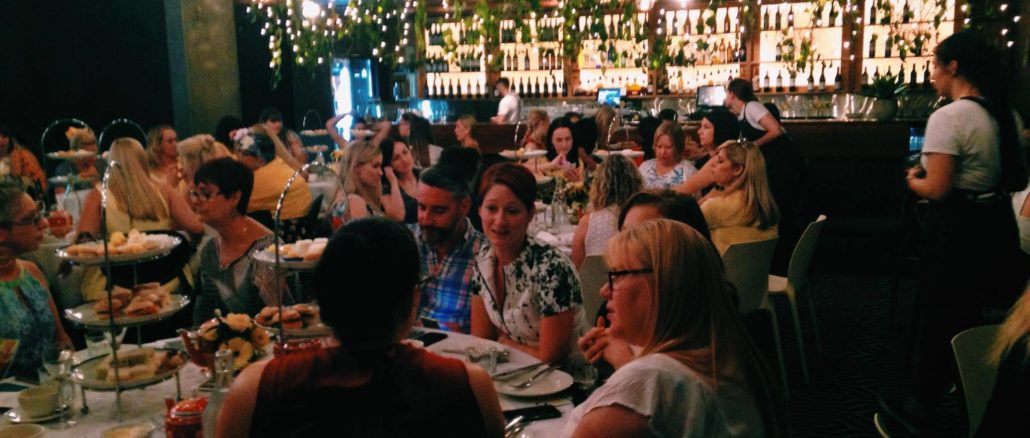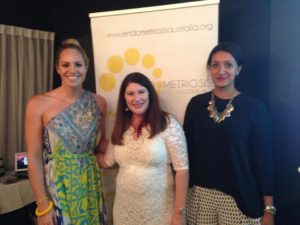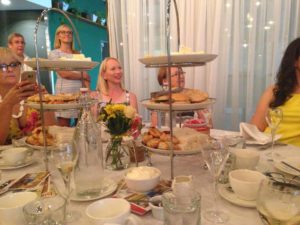
I am embarrassed to say that before being invited to the EndoMarch High Tea I didn’t really know a lot about endometriosis. I’ve had friends who over the years have said it was more difficult to fall pregnant or that their periods were painful because of this disease but they just seemed to soldier on. I was shocked when I heard that 1 in 10 women worldwide are diagnosed with endometriosis and that it can take 7-10 years for the condition to be properly diagnosed.
Thanks to the speakers I listened to at the EndoMarch High Tea I now have a greater understanding and am aware of the vital funding needed to combat this disease.
 MC for the day- health advocate and businesswoman Balveen Ahjamil and Olympic swimming champion- Emily Seebohm spoke candidly about their battles with endometriosis. Professor Arusch Yadzani – endometriosis specialist spoke about the disease and treatment options. Professor Grant Montgomery, from UQ, who is studying the genetic components of this disease, gave hope by outlining the progress that has been made in the last ten years through vital research into endometriosis.
MC for the day- health advocate and businesswoman Balveen Ahjamil and Olympic swimming champion- Emily Seebohm spoke candidly about their battles with endometriosis. Professor Arusch Yadzani – endometriosis specialist spoke about the disease and treatment options. Professor Grant Montgomery, from UQ, who is studying the genetic components of this disease, gave hope by outlining the progress that has been made in the last ten years through vital research into endometriosis.
What is Endometriosis?
Endometriosis often starts when women are teenagers. Symptoms are variable which may explain why it can take so many years to be diagnosed. It’s a common disease in which tissue that is similar to the lining of the womb grows outside it in other parts of the body.
Common symptoms include pelvic pain, painful,heavy and prolonged periods and for some women fertility can be affected.
Ambassador, stunning gold medal winning swimmer Emily Seebohm says, “As a teenager I thought this was how everyone must feel. It was hard being a swimmer suffering with this condition but I just had to became mentally tougher. Some days you just didn’t want to get out of bed. “Emily was formally diagnosed with endometriosis in June last year. The Olympics were in August. She delayed treatment until this year and has had a very good outcome. She now has more energy and has her sights set on the 2018 Commonwealth Games. Ambassador Balveen Ahjamil gave us an honest account of her struggle with endometriosis and introduced us to everyday hero-Laura who is wearing yellow every day in March to raise money for the cause. To date she has raised over $2000 dollars and has a goal of $3000. These funds are much needed for further research and education. Check out her colourful outfits and story online.
Treatment
Professor Arusch Yadzani outlined treatment options and urged women to, “take control of your health, keep records and speak to a specialist in this field to see which assessment and treatment options might be right for you. He reassured us that many women will not experience fertility problems.”
Speaking to some ladies at the High Tea I was heartened to hear stories of women who thought they would never have children because of endometriosis, who now have happy, healthy families, much to their surprise and delight. For many it was the first time they’d talked about having endometriosis and the first time they’d met with other women who were suffering from the same disease. A few tears may have been shed.
 Professor Grant Montgomery explained, “Endometriosis is a complex disease but in the last ten years enormous progress has been made. At UQ we are busy mapping genes and are hoping that in the next few years we will be able to shed some light on the mechanisms of this disease.”
Professor Grant Montgomery explained, “Endometriosis is a complex disease but in the last ten years enormous progress has been made. At UQ we are busy mapping genes and are hoping that in the next few years we will be able to shed some light on the mechanisms of this disease.”
The elegant and delicious High Tea at Darling & Co was one of many held around the world to help raise funds for research, education and awareness. Endometriosis is a disease which affects women in their reproductive years and beyond so it’s important to educate young women and to begin the conversation earlier. Show your support by wearing yellow this month or go to Endometriosis Australia to find out more. Let’s Put An End To Endo.
Michelle Beesley is a Brisbane born and bred former primary school teacher. A wife, proud grandma and mother of three grown sons, Michelle is thrilled to have recently published her debut contemporary romance novel, It Happened in Paris, with Serenade Publishing. Her novella – Escape to D’ Amour was published in 2019. Michelle’s work can be found in the anthologies – Destination Romance and Short & Sweet. When not reading or writing Michelle can be found at a coffee shop chatting with friends, front row at a fashion show, or beside a rugby union field cheering on her favourite teams.
Michelle is a reluctant traveller, Francophile, keen walker and avid yoga enthusiast plus a book, film and theatre lover who loves everything pink and sparkly (including champagne). You can find Michelle on instagram @michellebeesley_writer and her website: michellebeesley.com.


Leave a Reply